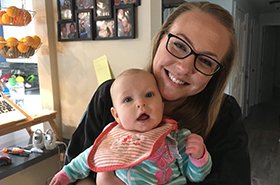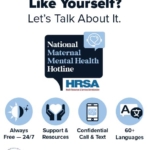Over the last few weeks, there has been a lot of coverage of a story involving a new mother from Sacramento. You can read the details of the story here and here. Basically, a new mother, Jessica, came to see her obstetrician with her 4-month old baby, explaining, “That I have postpartum depression that is manifesting in fits of anger, and I want to discuss my medication options. I tell them I have a very strong support system at home, so although I would never hurt myself or my baby, I’m having violent thoughts and I need medication and therapy to get through this.”
Jessica was expecting to speak to her obstetrician about treatment; however, the police were called and Jessica was escorted to an emergency room for further evaluation. Ultimately she was released, ten hours later, after being evaluated by a psychiatric social worker.
Jessica’s story, which she posted on Facebook, triggered a flood of comments, many offering support or expressing outrage; however, Jessica’s story is complex, and to take sides or to say that what happened was “wrong” or “crazy” doesn’t really help us or women like Jessica.
When a woman comes into a healthcare provider’s office and reports concerning symptoms, it is the health care provider’s duty to evaluate those symptoms and to make a decision on what to do next to ensure that patient’s well-being and safety. If we imagine that Jessica had reported sudden onset of chest pain, instead of depression, she would have been transported to the emergency room to be evaluated, to make sure that she was not having a heart attack. Although we would like it to be, medical decision-making is not a perfect science. We observe, we collect information, we make clinical judgments. When we make decisions, especially when things are not so clear, we must err on the side of safety.
So when a woman comes in to her provider’s office with “fits of anger” and “violent thoughts”, we must take them seriously. Yes, scary, and sometimes violent, intrusive thoughts can be a symptom of postpartum depression or obsessive-compulsive disorder, and typically women do not act on these thoughts. But sometimes violent thoughts may signify a more significant type of psychiatric illness, such as postpartum psychosis, which might place both the mother and her child at risk. The nurse practitioner was concerned enough to make sure that Jessica received further evaluation. And that’s a good thing.
But what happened next — being taken by the police to the emergency room for further evaluation — is what upsets us all. Jessica felt like a criminal when she was just asking for help.
It is easy to feel anger and outrage when one hears this story; however, this is not a black and white kind of situation and to point fingers and to criticize is not going to help make things better. The last thing we want to do is make women hesitant or afraid to tell their doctors what they are experiencing, nor do we want doctors to avoid asking important questions and to shy away from doing what they need to do to ensure the safety of the mother and her child.
Over the last decade we have witnessed so many advances in terms of our attention to maternal mental health: the MOTHERS Act, American College of Obstetricians and Gynecologists (ACOG) and U.S. Preventive Services Task Force recommending screening for depression in all pregnant and postpartum women, the passage of the 21st Century Cures Act which earmarked resources for the development of programs supporting maternal mental health. Perinatal depression has come out of the shadows, with a host of celebrities, starting with Brooke Shields, forcing the public and the healthcare industry to pay greater attention to the mental health of mothers.
But these advances have come at a time when mental health services are shrinking and becoming more costly, and what causes so many problems is this unfortunate mismatch between an increasing number of women seeking help and our inability to provide what they need. Back in 2005, the New Jersey Postpartum Wellness Initiative was established Governor Richard Codey to increase awareness of and improve screening for postpartum depression; however we soon discovered that we did not have enough mental health professionals with expertise in this area to provide services.
We have tried to overcome the inadequacy of our mental health services in our healthcare system by recruiting ancillary providers — for example, using obstetric providers to screen for and manage perinatal depression. Noting that screening alone cannot improve clinical outcomes, ACOG notes that screening “must be coupled with appropriate follow-up and treatment when indicated,” and – most critically – adds that obstetric providers “should be prepared to initiate medical therapy, refer patients to appropriate health resources when indicated, or both.” The latter recommendation is followed by the statement that “systems should be in place to ensure follow-up for diagnosis and treatment.”
While there are now more programs offering training to obstetricians, midwives, and nurses so that they can better identify, and even manage, perinatal mood and anxiety disorders, I expect that many obstetric providers may feel uncomfortable assuming the care of this patient population.
Getting back to Jessica’s story, I suspect that the nurse practitioner who examined her was probably uncomfortable in making a decision based on her evaluation. So she did what she was supposed to do: she ensured the patient’s safety and arranged for further evaluation. Because this obstetrics office did not have their own mental health provider on site, the provider was forced to have the police take her to the nearest emergency room. And in the emergency room, Jessica did what people do in emergency rooms in the United States: she waited and waited and waited.
While postpartum depression is common and affects about one out of every seven women who give birth to a child, it is not always so easy to make the diagnosis. What we loosely call “postpartum depression” encompasses a wide variety of presentations, ranging from the mildest form of mood disturbance — postpartum blues — to much more severe, and potentially dangerous, forms of psychiatric illness, such as postpartum psychosis.
There is no blood test we can run, or CT scan or MRI we can order, which will confirm the diagnosis. We don’t have a standardized questionnaire which we can use to accurately predict which women are at risk for harming their child or themselves. It’s 100% clinical judgment.
A thorough evaluation of a women with PPD takes time, and it takes experience. I have been specializing in the evaluation and treatment of women with PPD for 21 years. And still, after all those years, when I hear a story like Jessica’s, it is unsettling to me. When a mother with postpartum depression tells me she is having violent thoughts or thoughts of harming herself, even when she tells me she has no intention of acting on them, an alarm goes off. I automatically know I will have some difficult clinical decisions ahead to me. What makes postpartum depression so tricky is that it sits on the line between sick and really sick. If I conclude that this woman has the blues or depression or OCD, I will most likely make some recommendations and send her home to her family. But if I find that she has severe depression or postpartum psychosis, it’s an emergency. Because postpartum psychosis can lead to suicide and infanticide, we typically hospitalize women with postpartum psychosis to ensure the safety of the mother and her baby.
Postpartum women and their children are an incredibly vulnerable population, and we can’t afford to mess this up. We have to make the system better, and I am grateful to women like Jessica who can share their experiences so that we can improve how we support and care for expectant and new mothers.
Ruta Nonacs, MD PhD






Thank you for your reasoned reaction to this story. In our rapid news cycle society, stories tend to get reported in a manner that generates public indignation and emotional reactions. Upon hearing the story, we automatically put ourselves in the position of the “victim.” While the experience would certainly be uncomfortable and distressing to any new mom, our legal and mental health systems are designed to err on the side of safety, especially where there is the possibility of harm to children or the elderly.
I am a Perinatal Psychologist in private practice in Sacramento. I am aware of the need to develop a specialized resource network to address this public health issue. I am grateful to Jessica Porten for sharing her story as an advocate seeking to improve the experiences of other women. Thank you for featuring this story.